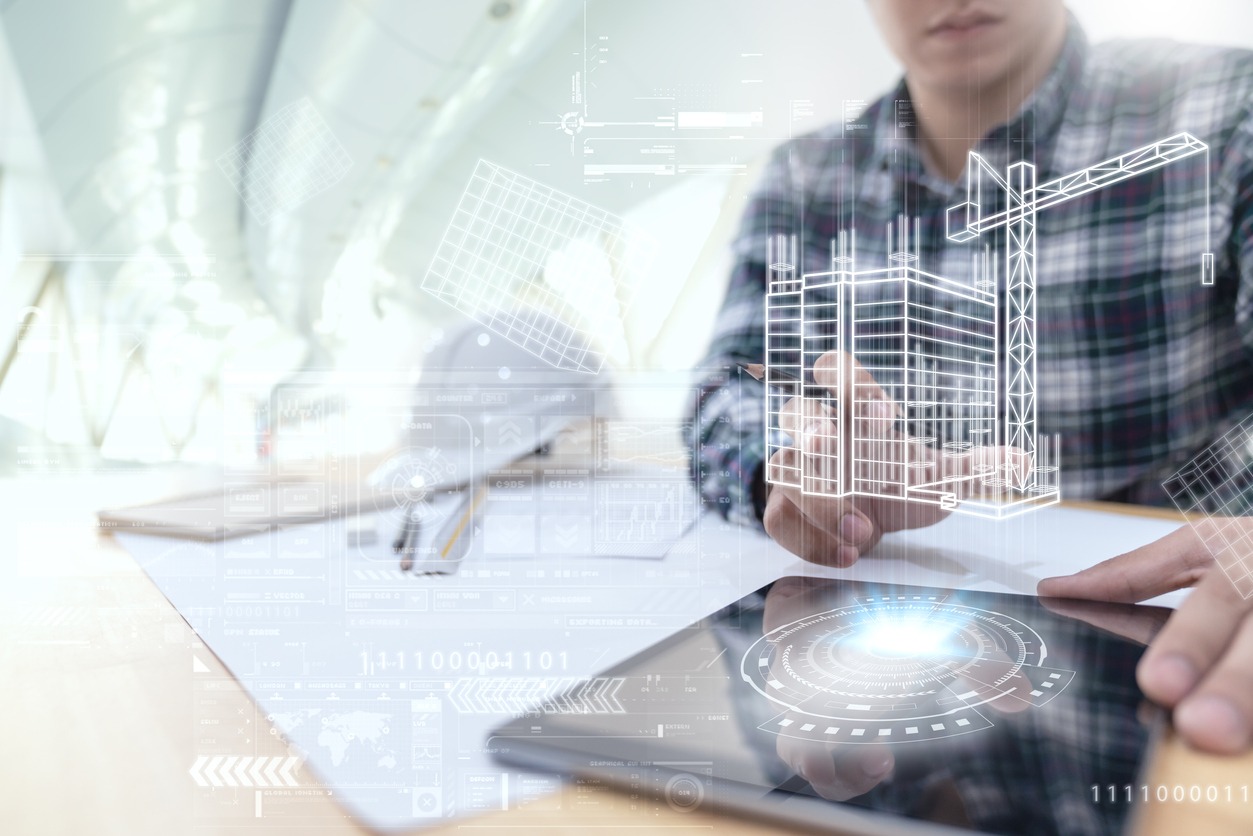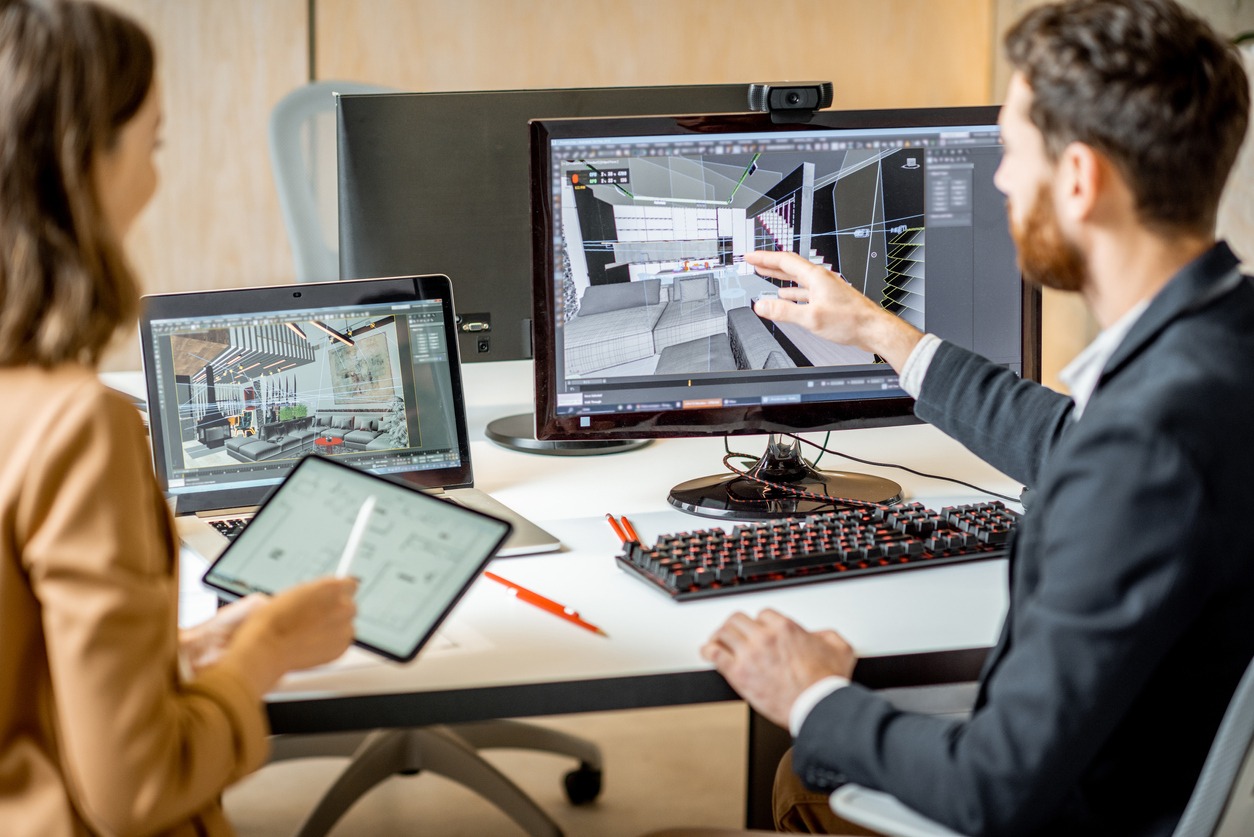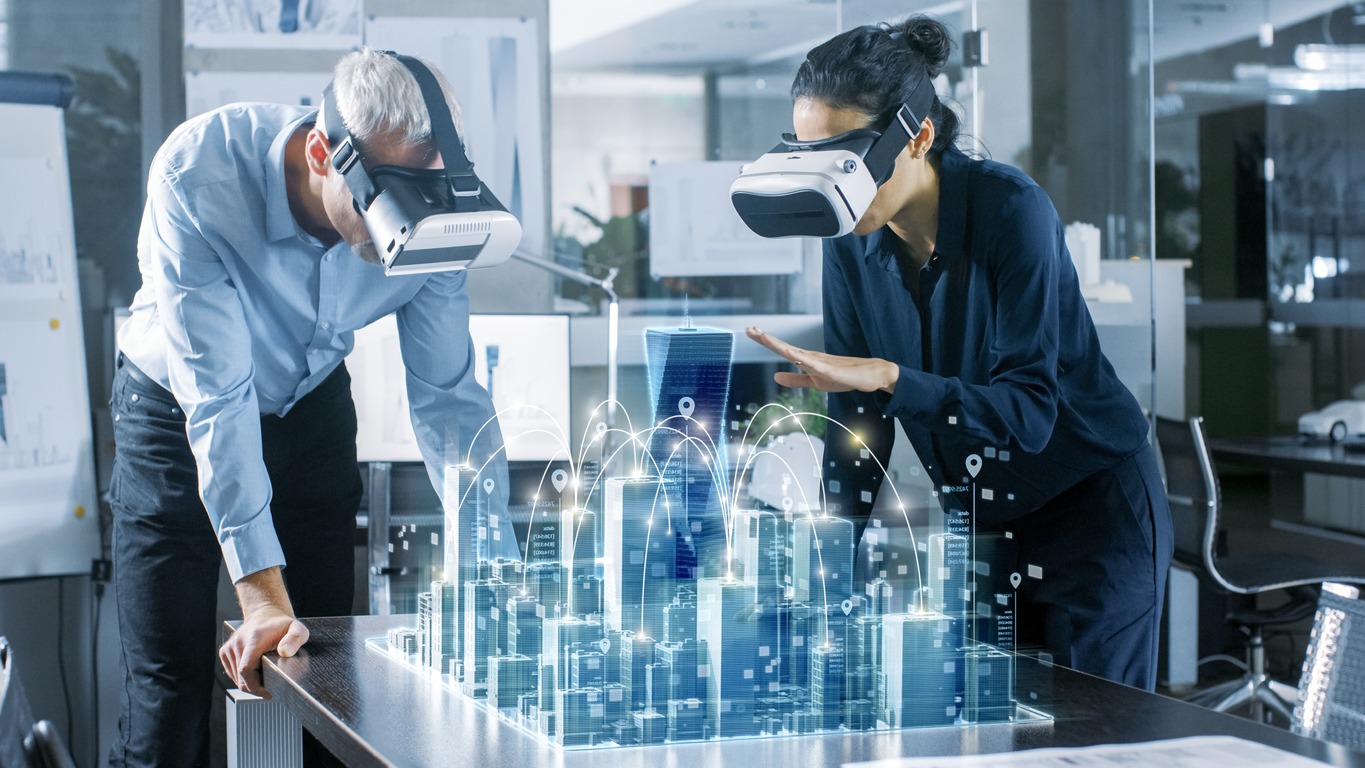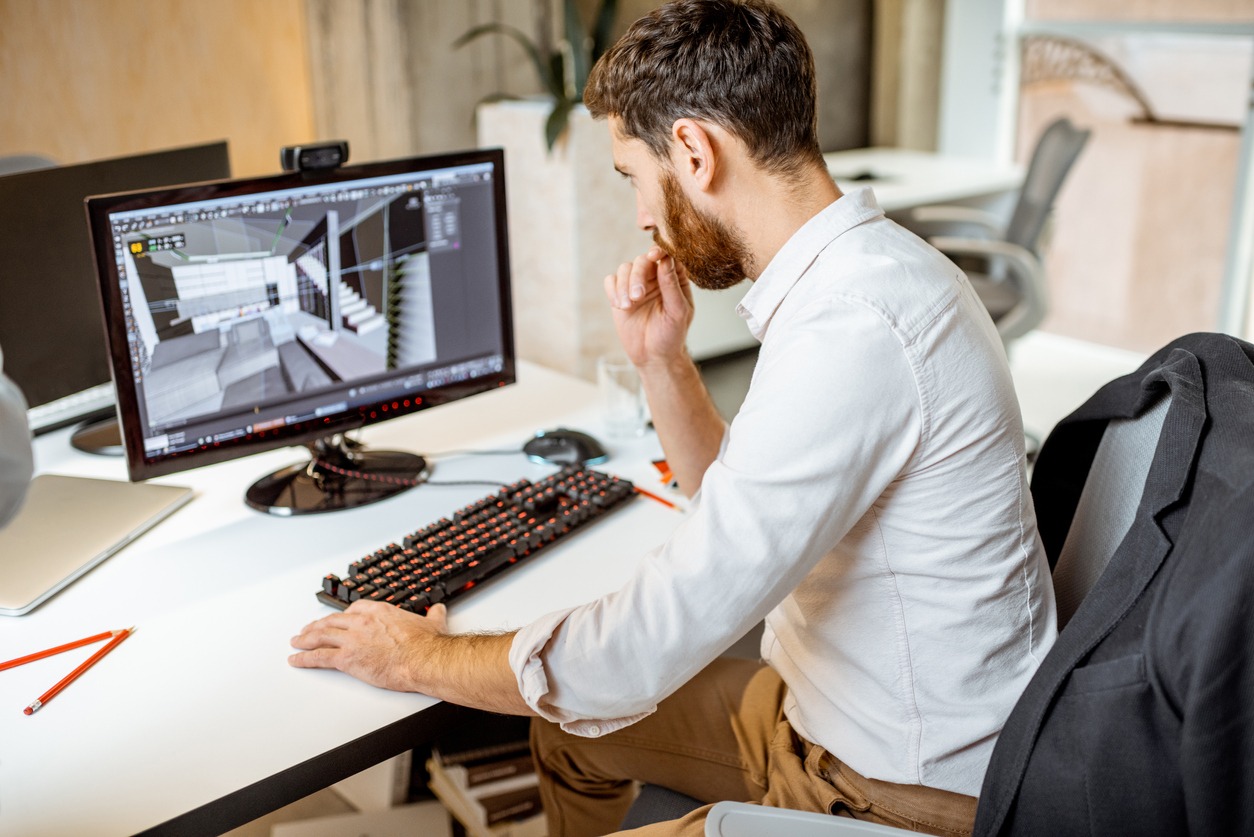In the ever-evolving world of architecture, technology plays a pivotal role, fundamentally altering how architects design, plan, and construct buildings. The integration of digital tools and innovations into architectural practices is not just reshaping our physical spaces but also redefining the very essence of design principles. This blog post delves into the multifaceted ways technology impacts architecture, revealing a future where the built environment and digital innovations converge seamlessly.
Brief History of Technological Advancements in Architecture
The history of technological advancements in architecture is a fascinating journey that mirrors the evolution of human civilization. From the ancient use of basic tools to the sophisticated digital technologies of the modern era, each phase has significantly impacted how buildings are designed, constructed, and experienced. Here’s a brief overview of this journey:
Ancient and Classical Periods
- Stone Tools and Basic Machines (Prehistoric Times): Early humans used primitive tools like hand axes for cutting and shaping natural materials. The construction of megalithic structures like Stonehenge demonstrates the sophisticated use of basic technology in ancient times.
- The Lever and Pulley (Ancient Egypt and Greece): The Egyptians utilized simple machines like levers and pulleys to construct monumental structures like the Pyramids. In Ancient Greece, architectural design began to evolve with the use of more refined tools and mathematical principles.
Middle Ages and Renaissance
- Gothic Architecture and Flying Buttresses (12th – 16th Century): The development of flying buttresses in Gothic architecture represented a significant technological advancement, allowing for taller buildings with larger windows.
- Renaissance and Perspective Drawing (14th – 17th Century): The Renaissance era introduced perspective drawing, enabling architects to create more accurate and realistic design plans. This period also saw the rediscovery and application of ancient Greek and Roman architectural principles.
Industrial Revolution
- Iron and Steel Construction (18th – 19th Century): The Industrial Revolution brought about major changes with the introduction of iron and steel in construction. This led to the development of skyscrapers and large-span structures, dramatically altering city skylines.
- Elevators and Electrical Systems (19th Century): The invention of the elevator and the integration of electrical systems further transformed architectural possibilities, allowing for higher and more functional buildings.
20th Century
- Modernist Movement and New Materials (Early 20th Century): The Modernist movement embraced new materials like concrete, glass, and steel, leading to minimalist designs and the concept of form following function.
- Computer-Aided Design (CAD) (Late 20th Century): The advent of CAD software revolutionized architectural drafting, moving from hand drawings to digital design. This allowed for more precise and complex architectural planning.
21st Century and Beyond
- Building Information Modeling (BIM) and 3D Printing: BIM technology has become crucial in modern architecture for efficient and collaborative design processes. 3D printing is also emerging, enabling the creation of complex forms and potentially revolutionizing construction methods.
- Virtual and Augmented Reality: VR and AR technologies are increasingly used for immersive design visualization and client presentations.
- Sustainable and Smart Technologies: The focus on sustainability has led to the integration of eco-friendly materials and smart technologies in buildings, aiming for energy efficiency and reduced environmental impact.
- Artificial Intelligence and Machine Learning: AI and ML are beginning to influence architectural design and urban planning by optimizing designs for various factors, including environmental sustainability and user comfort.
The history of technological advancements in architecture is a testament to human ingenuity and the relentless pursuit of improvement in how we design and construct our living spaces. From ancient techniques to futuristic innovations, each advancement has not only addressed the challenges of its time but also opened new possibilities for the future of architectural design. Explore on the Greek architecture using columns. Visit From Earth to Elegance – The Evolution of Doric Columns from Limestone to Marble
From Manual Drafting to CAD (Computer-Aided Design)
The transition from manual drafting to Computer-Aided Design (CAD) in architecture represents a pivotal shift in how architects and designers conceptualize, visualize, and plan buildings. This transition wasn’t just a change in the tools used; it marked a fundamental transformation in the design process itself, influencing everything from the speed and efficiency of drafting to the complexity and scope of architectural projects.
Manual Drafting: The Traditional Approach
Before the advent of CAD, manual drafting was the cornerstone of architectural design. This process involved drawing architectural plans by hand on drafting tables, using tools like T-squares, compasses, rulers, and protractors. Here are some key aspects of manual drafting:
- Skill and Precision: Manual drafting required a high level of skill and precision. Architects spent years mastering the art of drawing straight lines, perfect curves, and accurate perspectives.
- Time-Consuming Process: Creating and revising drawings was time-consuming. Any significant change often meant starting from scratch.
- Physical Storage: Physical copies of plans needed to be stored, which required significant space and posed challenges for managing and retrieving old projects.
- Collaboration Limitations: Collaboration was challenging, as it required physical presence or sending copies of plans through mail for any kind of joint work or review.
The Emergence of CAD
The introduction of CAD software in the late 20th century began a revolutionary change in architectural drafting. CAD allowed architects to create digital models of buildings, offering numerous advantages over manual drafting:
- Efficiency and Speed: CAD significantly accelerated the drafting process. Changes could be made quickly without the need to redraw entire plans.
- Improved Accuracy and Consistency: CAD programs offered greater precision. They also maintained consistency in the plans, as changes made in one part of the design automatically updated corresponding sections.
- 3D Modeling Capabilities: Unlike manual drafting, which was largely confined to two dimensions, CAD allowed for easy creation of 3D models, providing a more comprehensive view of how a structure would look and function.
- Digital Storage and Sharing: Digital storage of plans made it easier to manage, store, and retrieve documents. It also facilitated easier collaboration, as files could be shared electronically with team members anywhere in the world.
Impact of CAD on Architecture
The shift to CAD had a profound impact on architecture:
- Design Complexity: CAD enabled more complex and accurate designs. Architects could experiment with forms and structures that were difficult to visualize and draft manually.
- Iterative Design Process: With CAD, architects could easily experiment with different design options, leading to a more iterative and exploratory design process.
- Integration with Other Technologies: CAD became the foundation for other technological advancements in architecture, such as Building Information Modeling (BIM), Virtual Reality (VR), and even integration with Artificial Intelligence (AI) for design optimization.
- Democratization of Design: CAD software made architectural design more accessible. While manual drafting required years of training, CAD programs, with user-friendly interfaces, opened up the field to a wider audience.
The Revolution of Design Through Advanced Software
The cornerstone of architectural evolution in the digital age is the advent of sophisticated design software. Building Information Modeling (BIM) represents a paradigm shift, allowing architects to create comprehensive digital models that encapsulate both the physical and functional attributes of a building. Unlike traditional 2D blueprints, BIM provides a 3D model that offers an accurate visualization of a building, fostering a holistic understanding of the project. This depth of insight enables architects to make informed decisions, leading to more efficient and error-free construction processes.
3D modeling software, another critical tool, has expanded the horizons of architectural creativity. It allows architects to experiment with complex geometries and unconventional forms, pushing the boundaries of traditional design. The precision and flexibility offered by these tools have led to the emergence of new architectural styles and structures that were once deemed impossible.
Virtual and Augmented Reality
Virtual Reality (VR) and Augmented Reality (AR) are transforming the way architects and clients experience and interact with architectural designs. Through VR, individuals can immerse themselves in a fully rendered 3D environment, gaining a tangible sense of the space before it is physically constructed. This immersive experience aids in better understanding the spatial relationships and aesthetics of a design, enhancing client satisfaction and reducing the likelihood of costly post-construction changes.
AR adds another dimension to architectural visualization by overlaying digital information onto the physical world. It allows architects and clients to see how a new building will look in its actual environment, facilitating a more realistic assessment of the design in context.
Sustainable Design
With the global emphasis on sustainability, digital technologies are increasingly focused on creating energy-efficient and environmentally friendly designs. Advanced software tools enable architects to simulate a building’s energy consumption and environmental impact, guiding the creation of more sustainable structures. These tools assess various factors like solar radiation, wind patterns, and building materials, helping architects design buildings that are not only aesthetically pleasing but also ecologically responsible.
Digital Fabrication and 3D Printing
The construction aspect of architecture has been revolutionized by digital fabrication and 3D printing. These technologies allow for the production of complex, custom-designed building components, enabling a level of customization and intricacy previously unattainable. 3D printing, in particular, has opened up possibilities for using unconventional materials and creating forms that challenge traditional construction methods. This technology not only enhances design flexibility but also promises to reduce construction waste and costs.
The Emergence of AI and Machine Learning in Architecture
Artificial Intelligence (AI) and Machine Learning (ML) are beginning to make their mark in the architectural field. From optimizing building designs for energy efficiency to aiding in large-scale urban planning, AI algorithms are capable of analyzing vast datasets to suggest design modifications. AI can assist in predictive modeling, helping architects understand how a building will perform over time and under different conditions. This foresight is invaluable in creating structures that are both functional and sustainable.
Internet of Things (IoT) and Smart Buildings
The Internet of Things (IoT) is revolutionizing the way buildings function, making them ‘smart.’ IoT-enabled buildings are equipped with sensors and systems that automate and optimize various functions like lighting, heating, and security. This not only enhances the user experience but also significantly improves energy efficiency. As IoT technology advances, we can expect buildings to become more responsive to their occupants’ needs and environmental conditions, leading to a new era of intelligent architecture.
Collaborative Platforms
The impact of technology on architecture extends beyond design and construction; it also transforms how architects collaborate. Cloud-based platforms and advanced communication tools have enabled seamless collaboration among architects, engineers, contractors, and clients, irrespective of their geographic locations. This digital collaboration leads to more cohesive and well-coordinated projects, reducing misunderstandings and delays.
Adaptive and Responsive Design
Technology has enabled the development of buildings that can adapt and respond to environmental changes. Dynamic architectural elements, such as automated shading systems or ventilation that adjusts to temperature fluctuations, represent a leap towards buildings that are not only static structures but also responsive entities. This adaptive approach to design ensures that buildings can efficiently manage energy usage and provide optimal comfort for occupants.
The Future of Architecture
As we gaze into the future of architecture, it is evident that the integration of technology will continue to deepen. The convergence of the physical and digital realms will give rise to buildings that are not just structures but interactive, adaptive, and intelligent entities. This future is not merely about constructing spaces; it’s about creating environments that interact with their inhabitants and surroundings in profound and meaningful ways.
Smart Cities and Urban Planning
The impact of technology on architecture extends to the broader scale of urban planning and development. Smart city initiatives around the globe are leveraging technology to create urban environments that are efficient, sustainable, and livable. From traffic management systems that reduce congestion to public spaces that adapt to the changing needs of their users, technology is at the forefront of shaping the cities of the future.
The Role of Big Data in Architecture
Big data is becoming an invaluable resource in architectural design and urban planning. By analyzing vast amounts of data on traffic patterns, weather conditions, and population dynamics, architects and planners can design spaces that better cater to the needs of their users. Big data allows for a more evidence-based approach to design, leading to environments that are not only aesthetically pleasing but also functional and sustainable.
The Challenge of Cybersecurity in Smart Buildings
As buildings become more interconnected and reliant on digital technologies, cybersecurity emerges as a critical concern. Protecting the data and privacy of occupants in smart buildings is paramount. Architects and developers must collaborate with cybersecurity experts to ensure that these intelligent buildings are not only efficient and responsive but also secure from digital threats.
The Ethical Implications of Technology in Architecture
The integration of technology in architecture also raises important ethical considerations. Issues such as data privacy, the digital divide, and the environmental impact of new technologies are at the forefront. It is crucial for architects, technologists, and policymakers to work together to address these ethical challenges, ensuring that the benefits of architectural technology are accessible and equitable.
Lifelong Learning and Adaptability in the Architectural Profession
For architects, the rapid pace of technological advancement necessitates a commitment to lifelong learning and adaptability. Staying abreast of the latest digital tools, materials, and construction techniques is essential. Equally important is the ability to think critically about how these technologies can be applied to create spaces that are not only innovative but also humane and environmentally responsible.
Conclusion
The impact of technology on architecture represents a profound shift in how we conceive, design, and experience our built environment. As digital tools and innovations continue to evolve, they offer architects unprecedented opportunities to create spaces that are more efficient, sustainable, and responsive to human needs. However, this digital transformation also comes with challenges and responsibilities. Embracing these changes requires a delicate balance between innovation and ethics, creativity and sustainability, individual expression and collective well-being.
In this exciting era of architectural evolution, the possibilities are limitless. As we harness the power of technology, we can look forward to a future where architecture is not just about buildings but about creating holistic environments that enhance the quality of life for all. This journey towards a more integrated and responsive built environment is not just a technical endeavor but a creative and ethical pursuit, shaping the future of our cities, communities, and lives.






